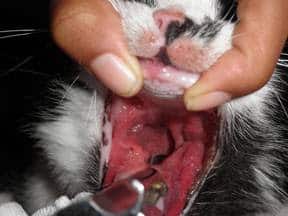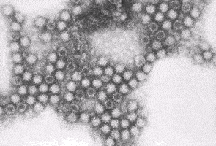(Also called lymphoplasmacytic stomatitis, LPS, feline caudal stomatitis, chronic oral inflammatory disease, or feline chronic gingostomatitis)
General physical examination involves an inspection of the teeth and mouth, provided that the patient is of a cooperative nature or has a mouth that is pain-free enough to allow examination. When we look, we often see plaque build-up, tartar, missing teeth and other dental conditions that result over a patient’s life. Sometimes, we see a specific type of gingivitis.
Consider a cat’s relatively healthy mouth. The teeth show fairly moderate to heavy tartar deposits but the soft tissues of the mouth are relatively normal. This cat needs his teeth cleaned but probably, beyond some periodontal disease, he does not have any major oral problems.

The cat on the left has plasma cell stomatitis. The gums are puffy, red, and irritated. The teeth have already been extracted to treat this condition. The area where the inflammation centers is the “fauce,” which is the area in the back of the mouth where the upper and lower jaws come together. Often this area is so painful that the cat can barely open her mouth, will hardly eat or groom herself, and will have stinky breath.
A biopsy is necessary to confirm the diagnosis of plasma cell stomatitis but the degree of inflammation can be very suggestive of the condition.
How Do Cats Get this Disease?

Sadly, we do not know how cats get this condition and, until we do, it will be hard to prevent. The condition seems to result from an inappropriate immune reaction against the plaque that forms on the teeth or other oral antigens. Most cats with this condition have been found to be chronic carriers of calicivirus, one of the common upper respiratory viruses of cats, and cats who are positive for feline immunodeficiency virus (FIV) and feline leukemia virus (FeLV) seem predisposed as well. Metabolic diseases that contribute to oral inflammation may also be afoot so it is important to run some blood tests to identify any fixable underlying causes. Which tests are recommended are determined on a case by case basis.
How Do we Treat it?
No single treatment seems to be appropriate for every patient but the basic principles in treating feline caudal stomatitis involve plaque control, inflammation control, pain control, and nutritional support.
Plaque Control / Extraction
Stringent control of plaque is crucial to managing these cats. Plaque is a mixture of food particles, bacteria and salivary proteins coating the teeth. Though it may seem dramatic, the best way to control the on-going oral reaction is to extract the teeth. Generally, all the molars and premolars (all the teeth from the fangs back to the throat) must be removed, including any root tips.
Full mouth extractions may seem extreme but this approach yields the best long-term results for most patients. In one study of cats with plasma cell stomatitis that had their molars and premolars extracted, 20 percent were improved to a point where medication could control the pain and inflammation and 60 percent were cured outright with no further treatment needed. The 60 percent number was increased to 90 percent when the canine teeth (fangs) were extracted as well.
Most of the cats that did not do well with full mouth extraction had been on medical management for months to years before extraction (there is a point where the inflammation is too well seated for extraction to work). The take-home lesson is not to consider full mouth extraction to be a last resort, but to pursue it early in the course of the condition so as to get the best possible results.
Full mouth extraction is not inexpensive and referral to a dental specialist may be needed (talk to your veterinarian about it). Dental radiography is a must to ensure all the root tips have been removed and proper burring of the tooth socket is needed to ensure the periodontal ligament has been fullly obliterated and will not cause on-going inflammation. Pain medications is typically prescribed after extractions of this extent, but it is common for owners to report that right away cats appear less painful than before the extractions and accept food hungrily for the first time in months. Lack of teeth does not hamper a cat’s ability to eat in any way as food is commonly swallowed whole.
Inflammation and Pain Control
Caudal stomatitis is an immune mediated disease so medical management is centered on suppressing and controlling the excessive activity of the immune system. Cortisone-derivative medicines such as prednisone or triamcinolone are often helpful in relieving the inflammation. Again, because of the pain, oral medication may be difficult to administer. A compounding pharmacy can be used to convert the tablet into a palatable liquid but often a long acting injection is needed to initiate treatment. Frequently, long-acting injectable steroids such as methylprednisolone acetate (Depomedrol®) are used with favorable responses generally observed within one to two days. This may be very helpful particularly when the cat is so painful that he cannot accept food; within days of treatment the swelling and pain is alleviated greatly. Steroids such as these, however, are problematic with long-term use. Methylprednisolone acetate injections are associated with the development of diabetes mellitus plus their immune-suppressive nature may empower an underlying calicivirus infection and/or periodontal bacterial infections. In many cases, while it is helpful for short-term relief, it is probably not ideal for long-term control.
Cyclosporine, another immune-modulating medication, is gaining popularity for the treatment of caudal stomatitis inflammation. This product is available as an oral liquid and has fewer associated side effects compared to the steroids. Rapid results are not seen as with the steroids, but sometimes they are given together so that the cyclosporine has had time to reach its peak effect just as the steroid injection is waning.
Bacterial infection complicates plasma cell stomatitis so antibiotics such as clavamox or clindamycin are often prescribed, sometimes for long-term use (at least 4 weeks). These antibiotics are especially good for oral infections as they target anaerobic bacteria that live in the mineralized plaque covering the teeth. Other antibiotics may also be suggested.
During a particularly painful flare up, sometimes a fentanyl patch is helpful for pain control. This is a small plastic patch that is generally applied to the back of a foot. It releases a continuous supply of pain relief for five to seven days. Buprenorphine is another popular pain reliever for caudal stomatitis patients as it requires less oral manipulation; the liquid is simply squirted into the mouth and is absorbed directly with actual swallowing being unnecessary.
Miscellaneous Medications
Pentoxifylline helps red blood cells become more flexible, thus allowing oxygen to be carried deeper into damaged tissues to facilitate healing. It is emerging as an adjunctive treatment for caudal stomatitis.
Maropitant citrate (Cerenia®) was developed as a strong anti-nauseal but its unique mechanism of regulating the interaction of Substance P and the N-K Receptor has led to numerous uses for it. It appears to have pain-relieving and anti-inflammatory properties beyond its stomach-settling ones.
Other medications to try might include the use of interferon omega, an immune modulator that theoretically helps normalize immune reactions. This treatment has been effective for cats needing additional therapy after extractions yield only partial improvement, but it is not available in North America.
Bovine lactoferrin is a natural compound that is similarly immunomodulating and antibacterial. It can be formulated by a compounding pharmacy into a palatable liquid. Bovine lactoferrin is used to bathe the mouth tissues. Initial studies showed a large percentage of affected cats responded at least partially.
It is important to remember that medical management is not the first choice approach for most patients and that medications tend to get less and less effective over time. Extractions are best done early. Medication is helpful to get long-standing pain controlled quickly and as a supplement to patients who do not respond completely to extraction.
Summary
- Caudal stomatitis is a painful, chronic condition.
- Proper diagnostics including a mouth biopsy are needed to confirm the diagnosis and get the correct treatment.
- Extraction of the molars and premolars early in the course of disease yields the best long term results in most patients. Depending on severity, full mouth extractions may be needed
- Medical management is nest reserved for specific situations (flare ups, patients who need more than extractions, patients with no tooth-associated lesions)


